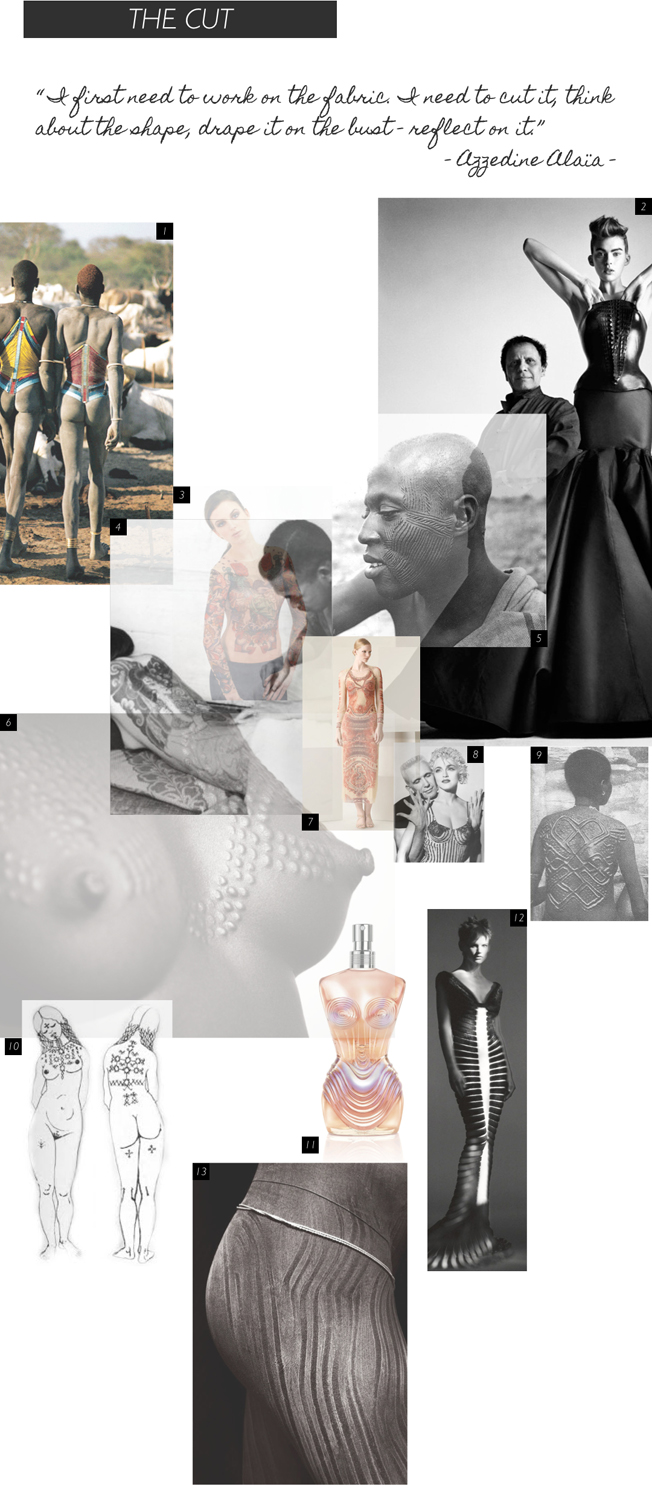I first need to work on the fabric. I need to cut it, think about the shape, drape it on the bust – reflect on it.
Azzedine Alaïa
IN THE SECOND INSTALMENT to our collaborative series ‘Sartorial Meditations’ with Another Africa, we look more closely at the various ways in which the continuity of fabric, and its endless potential, is cut into or interrupted by pattern and form.
From the exclusive realms of haute couture, to traditional systems of dress, there are processes that – although they sit as cultural polar opposites – share common themes. Cutting is a technique that creates form on the body; be it of the skin or fabric.
In the black and white photographic series ‘Omo’ by American photographer Drew Doggett we discover an image of a scarified bust depicting sculptural form on the body through the act of repetitive cutting as practiced by the Suri people in southern Ethiopia. The body’s surface is restructured in this process, likening it to the bottle of Jean Paul Gaultier’s ‘Classique’ perfume that sits beside it.
Images of traditional practices are objectified next to those of contemporary culture, dispersed in a broader context of fashion and dress. As such, it’s important to continuously re-frame the fashion image, to place one image against another playfully, and unexpectedly, to re-shuffle how we read images of fashion and the symbols of dress.
One of the failings of fashion theory and discourse is arguably that it insists on looking at the subject as a linear dialogue where one trend or cycle leads to another. Whereas, clothing could in fact be said to be a more dynamic phenomenon, constantly shifting and appropriating itself across time and place.
These images, deeply ingrained in our notion of dress, are also inextricably linked with geography in tracing a cultural narrative. For instance, when scarification and skin ornamentation, a traditional practice, is performed in a contemporary context, it has a renewed sense of spectacle and cultural connotations.
For a couturier, fabric might be viewed as an analogy of the skin, and as such, shaping and moulding material conjures up the possibilities of the body’s flexible membrane. The starkly stylised environments of Europe’s haute couture ateliers provide an extreme in this dynamic.
Azzedine Alaïa, widely known for his pattern cutting techniques and for skilfully sculpting the body through fabric, is perhaps the ultimate contemporary couturier. In contrast to many of his historical predecessors, his designs engage directly with the anatomy. What Alaïa and his contemporaries evoke is this crucial dynamic in dress – be it haute couture or ready-to-wear – as an alignment of the skin and the anatomy of the body in the act of wearing.
These notions of cutting as a sculptural art form that creates rhythm and form on the body, traverse fashion; whether it’s the tight beaded bodice of the Dinka men in South Sudan, the tattooed skin of a Japanese woman, the age-old traditions of scarification or the revered ‘cut’ of high fashion, evocative parallels abound.
To view fashion as a network of possibilities, connotations and connections that shift and percolate with different social conditions and factors, sets a precedent for this series which aligns some of the tensions within dress and its image.
Both high fashion and traditional systems share a technique and discipline that involves a rigorous process of repetition and discipline, but that ultimately celebrate the form and texture of the human body.
- ‘Two Dinka Men with Corsets, South Sudan’, by Angela Fisher & Carol Beckwith C-print, 76 x 52cm
- Azzedine Alaïa by Patrick Demarchelier, from Haute Couture spring/summer 2003
- A model wears Edward Lee tattoo shirt, featuring Americana artwork printed onto flesh-coloured mesh
- A Japanese tattoo artist works on a woman’s backside, photographer unknown
- Scarification c.1943, photographer unknown
- ‘Untitled 6’, from the series ‘Omo’, showing a Suri woman, by Drew Doggett
- Tattoo print tulle dress by Jean Paul Gaultier, 2013
- Jean Paul Gaultier poses with Madonna for French Glamour, June 1990, photograph by Herb Ritts
- Yombe woman, Congo c.1947. Photo by H.A. Bernatzik
- Amazigh tattoo pattern, Berber, Morocco
- Jean Paul Gaultier’s ‘Classique’ fragrance
- Azzedine Alaïa, ‘Powder Puff’ long sheath dress, spring/summer 1994, photograph by Paolo Roversi, 2013
- ‘Untitled’, from the series ‘Omo’, showing a Suri warrior, by Drew Doggett
Missla Libsekal is the founding editor of Another Africa.
